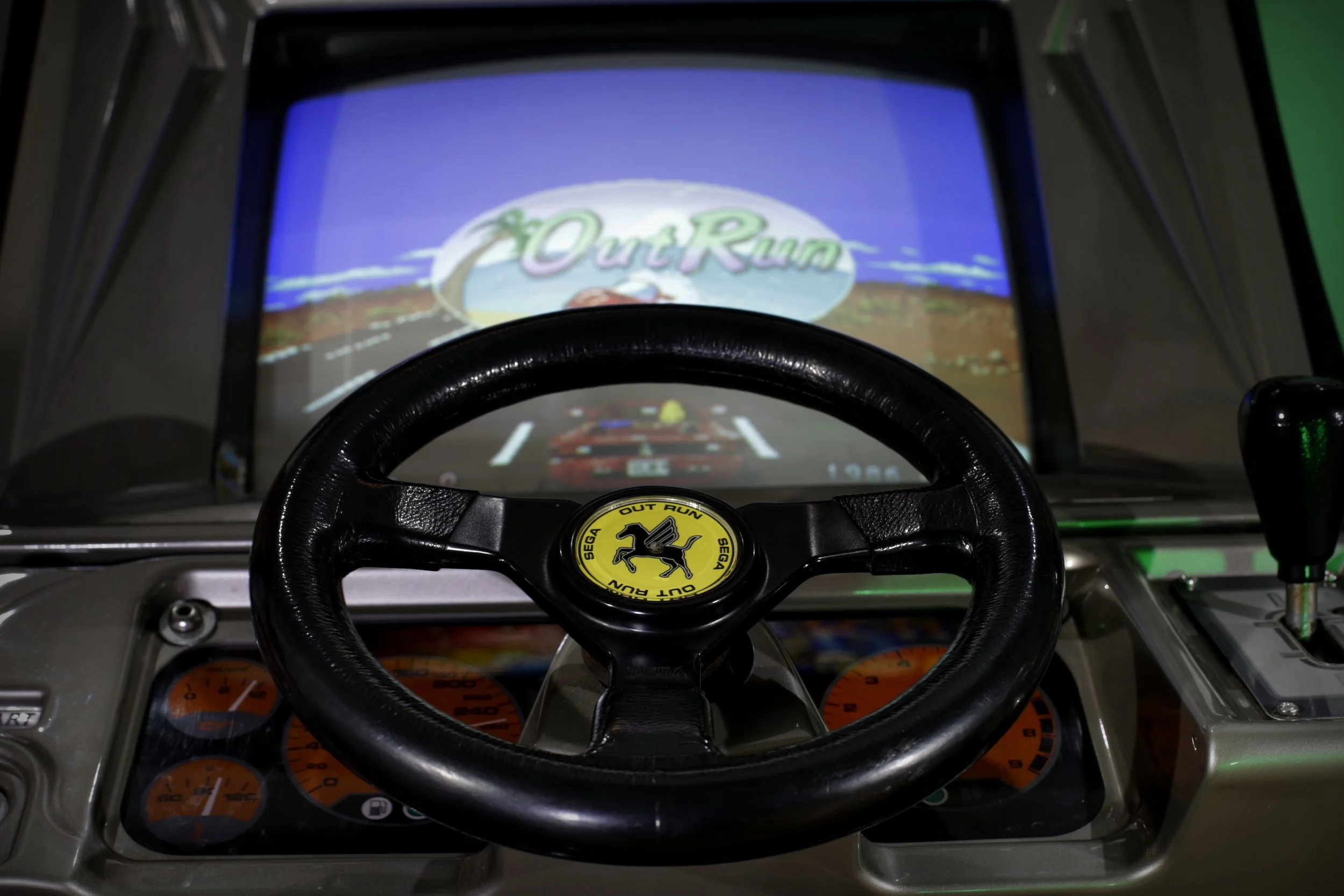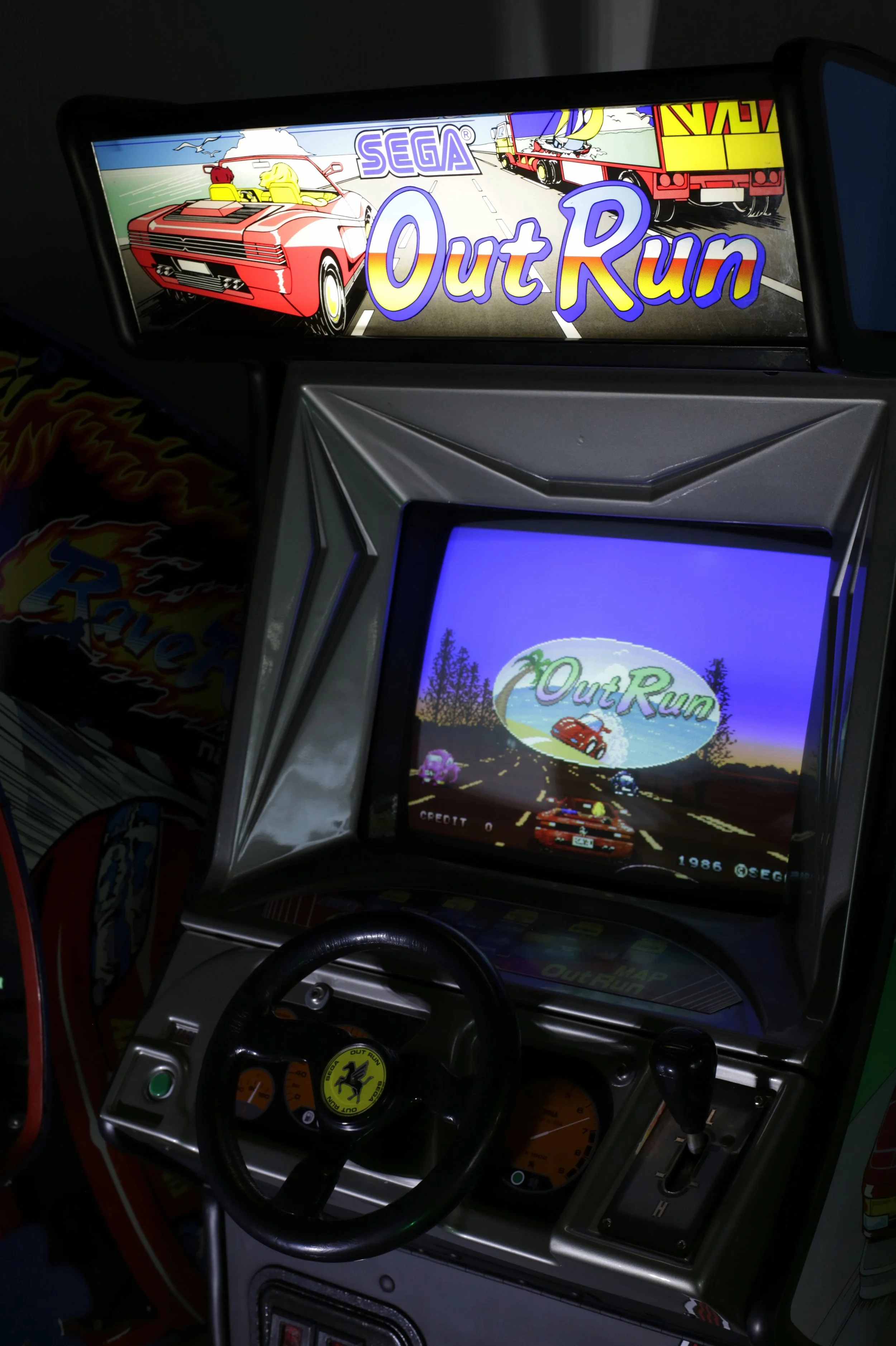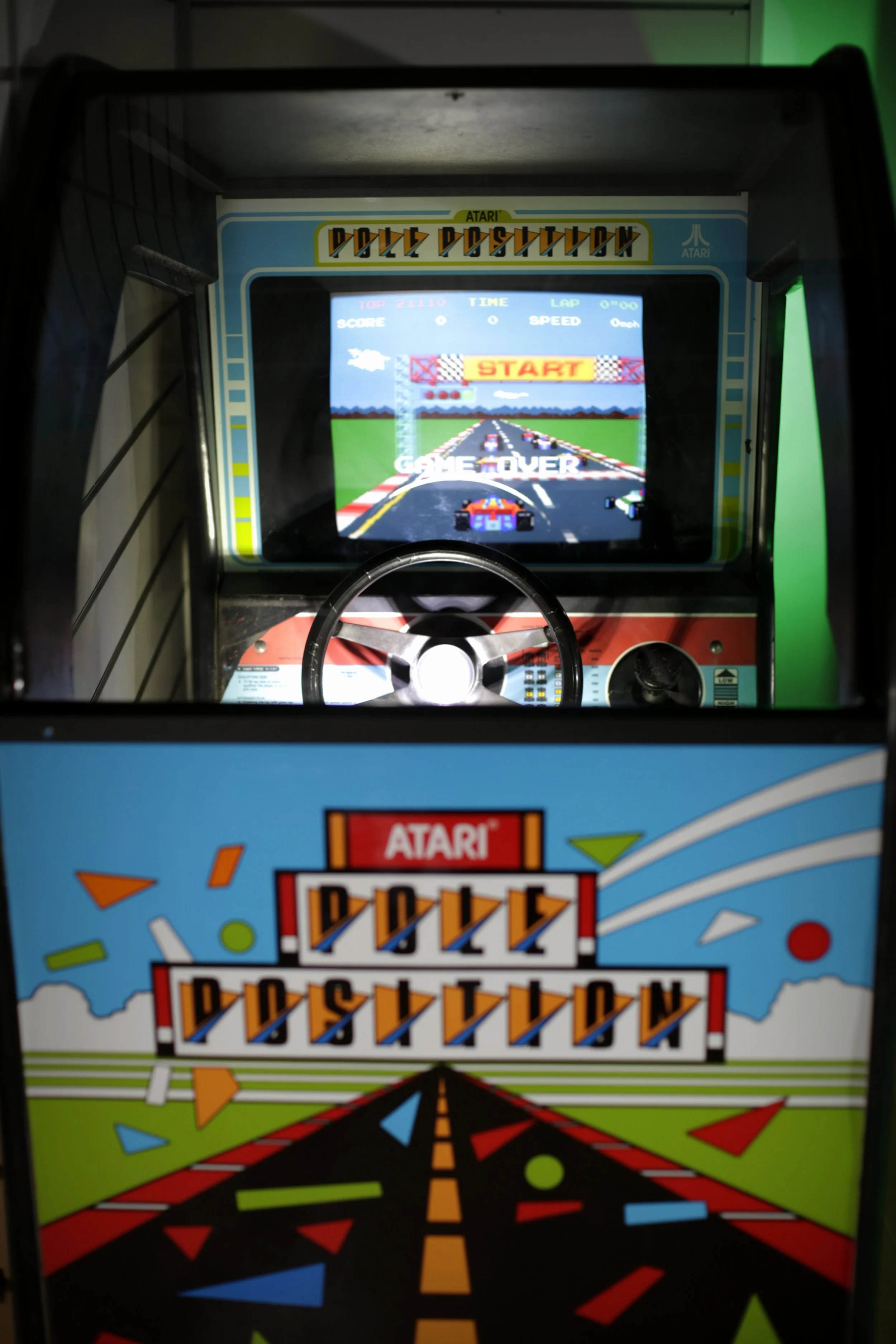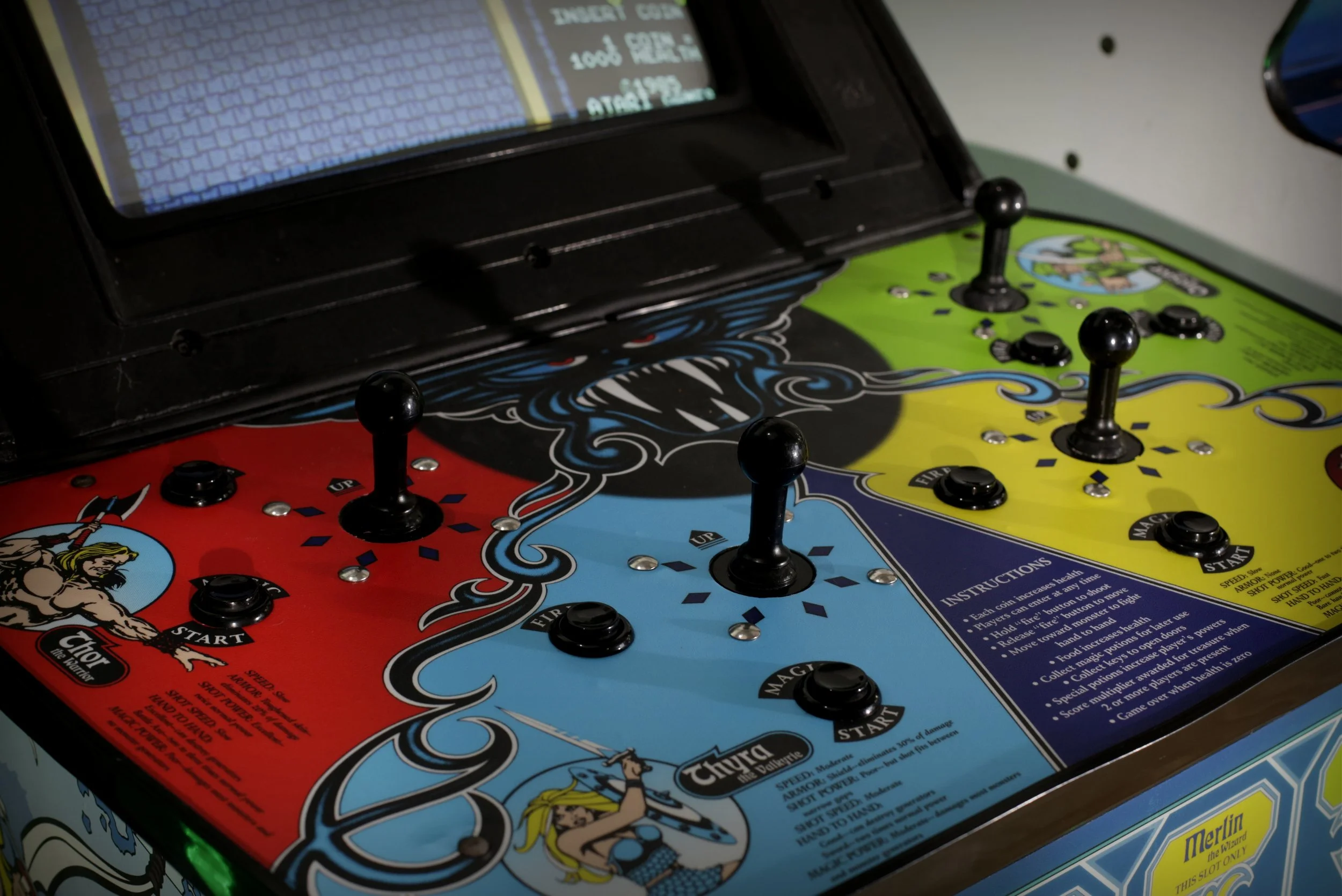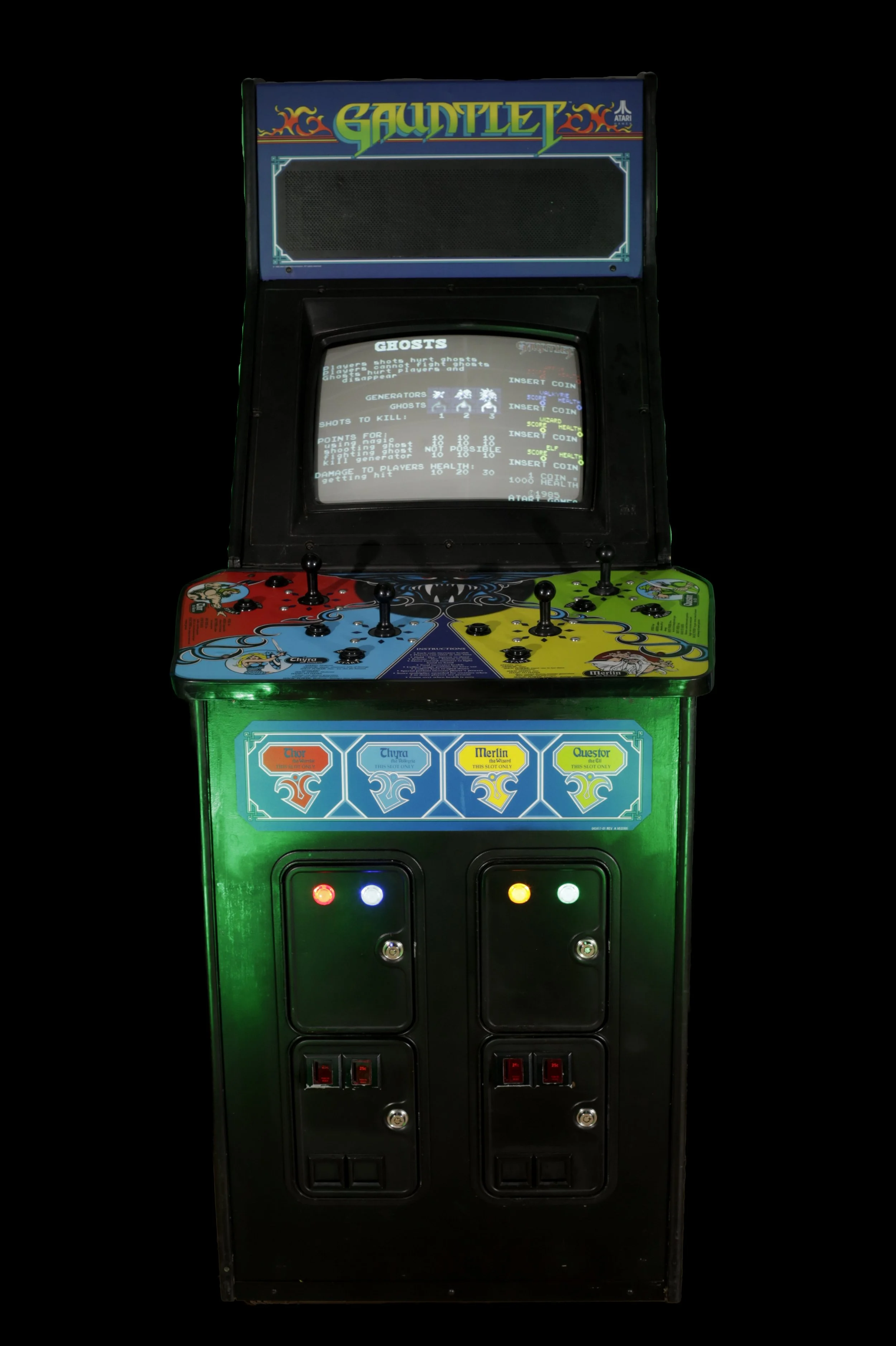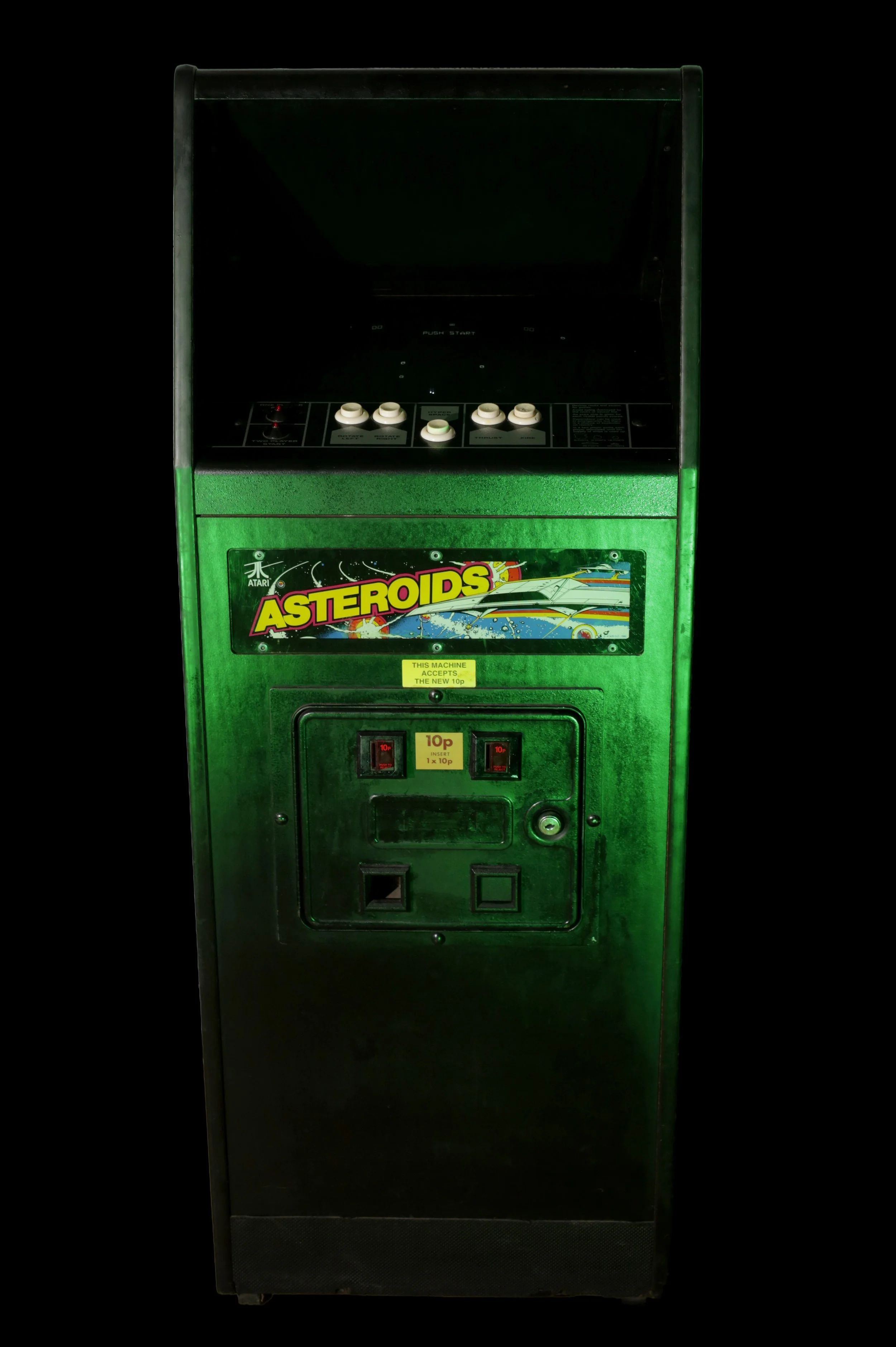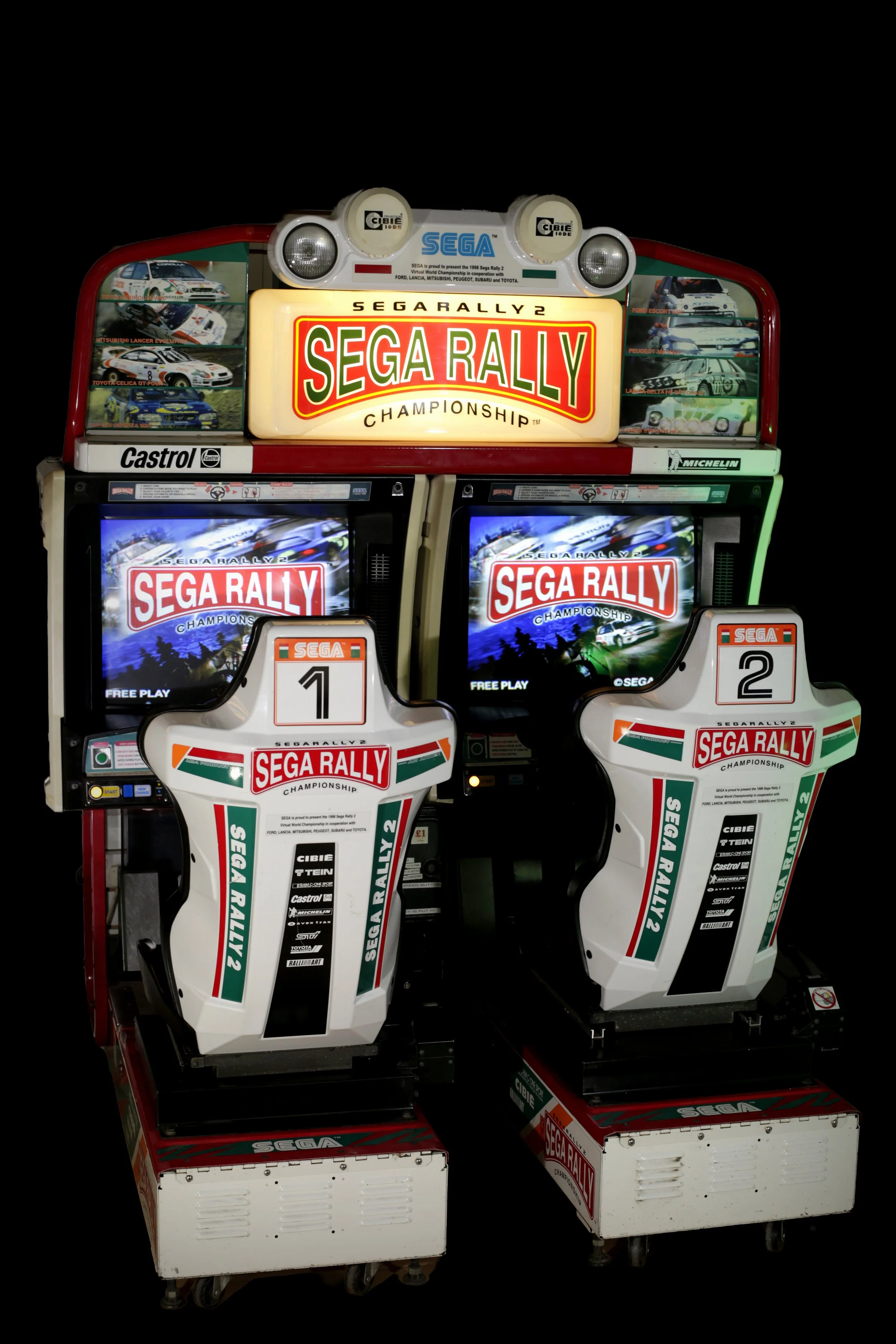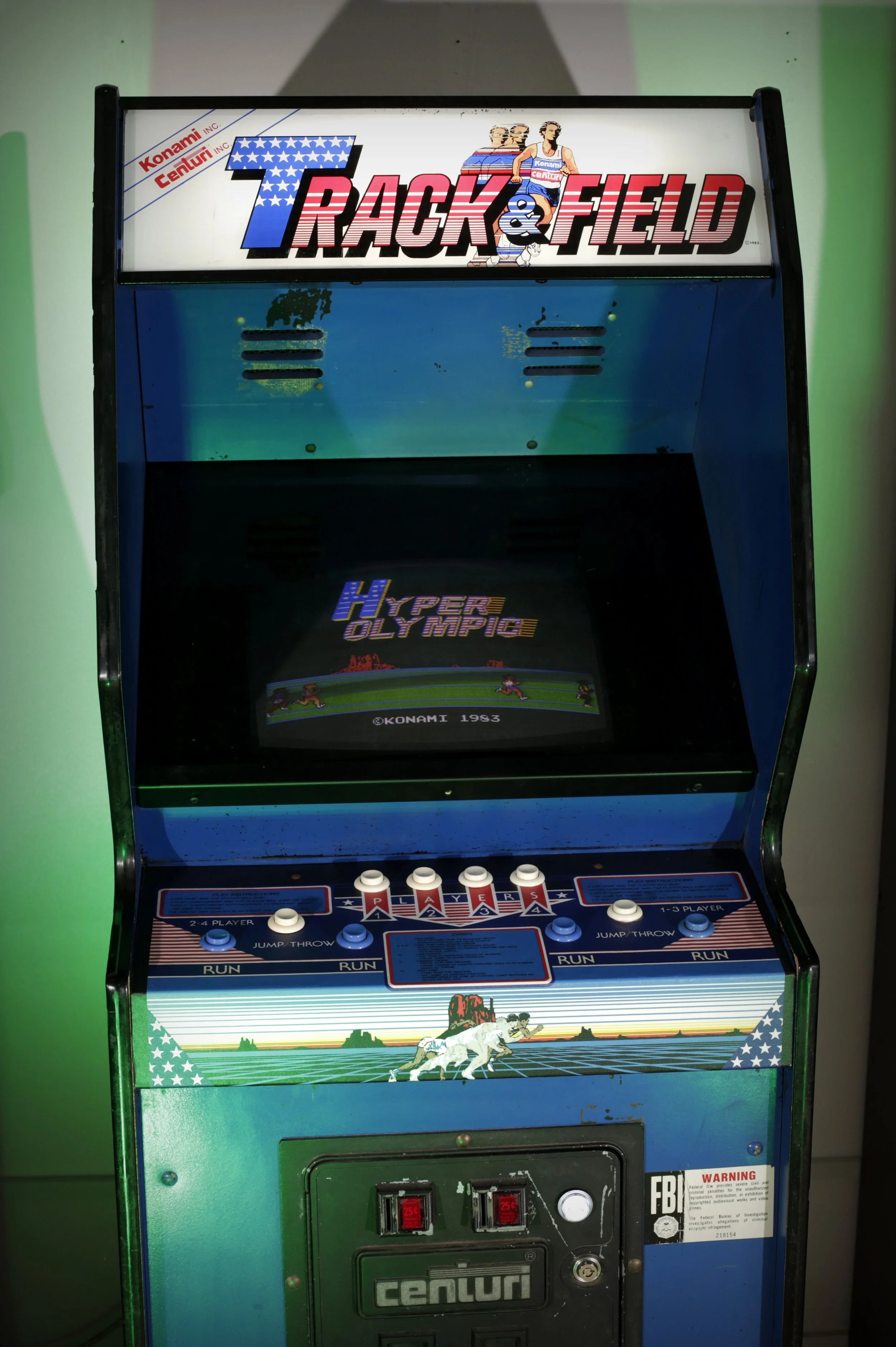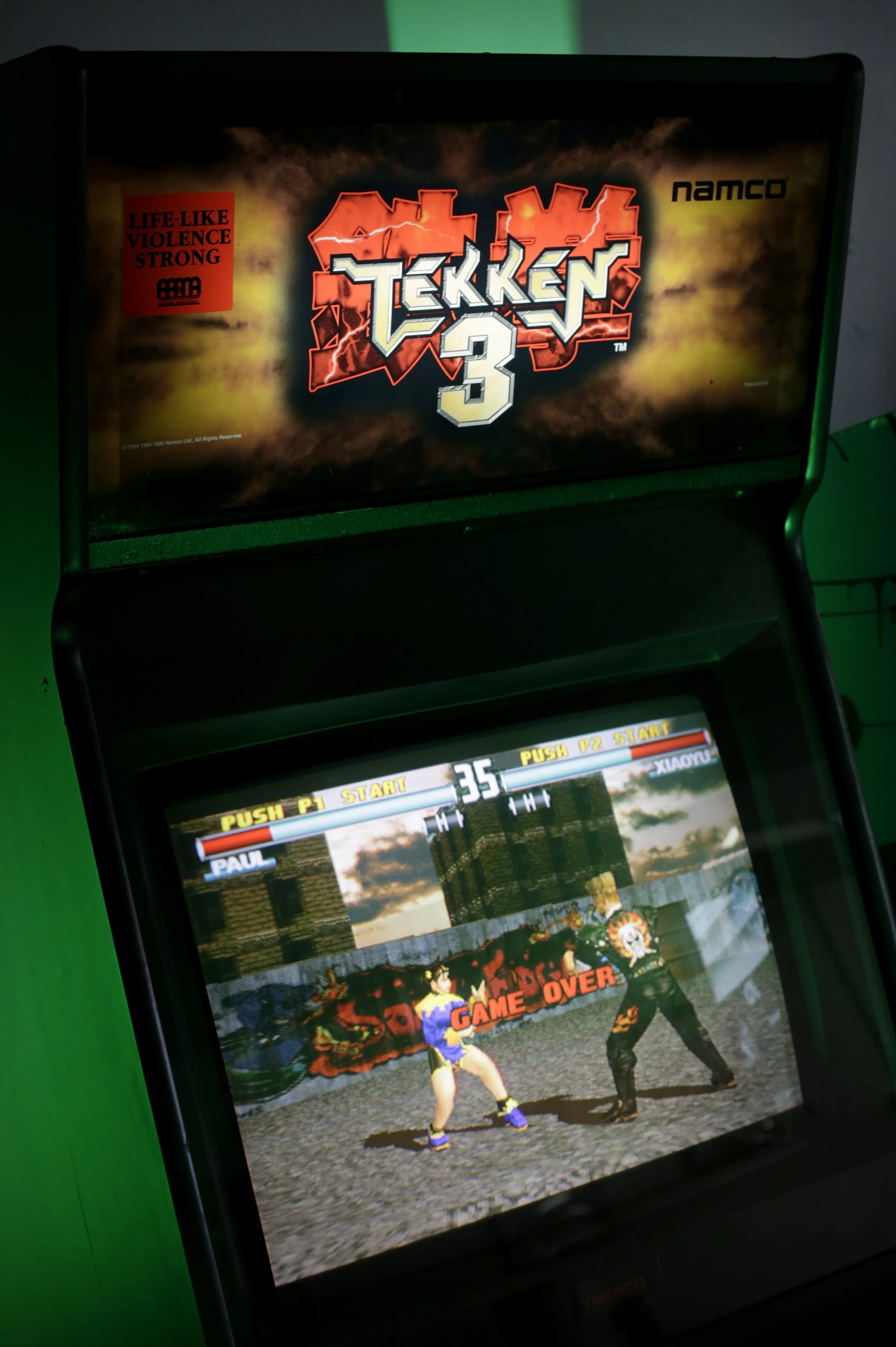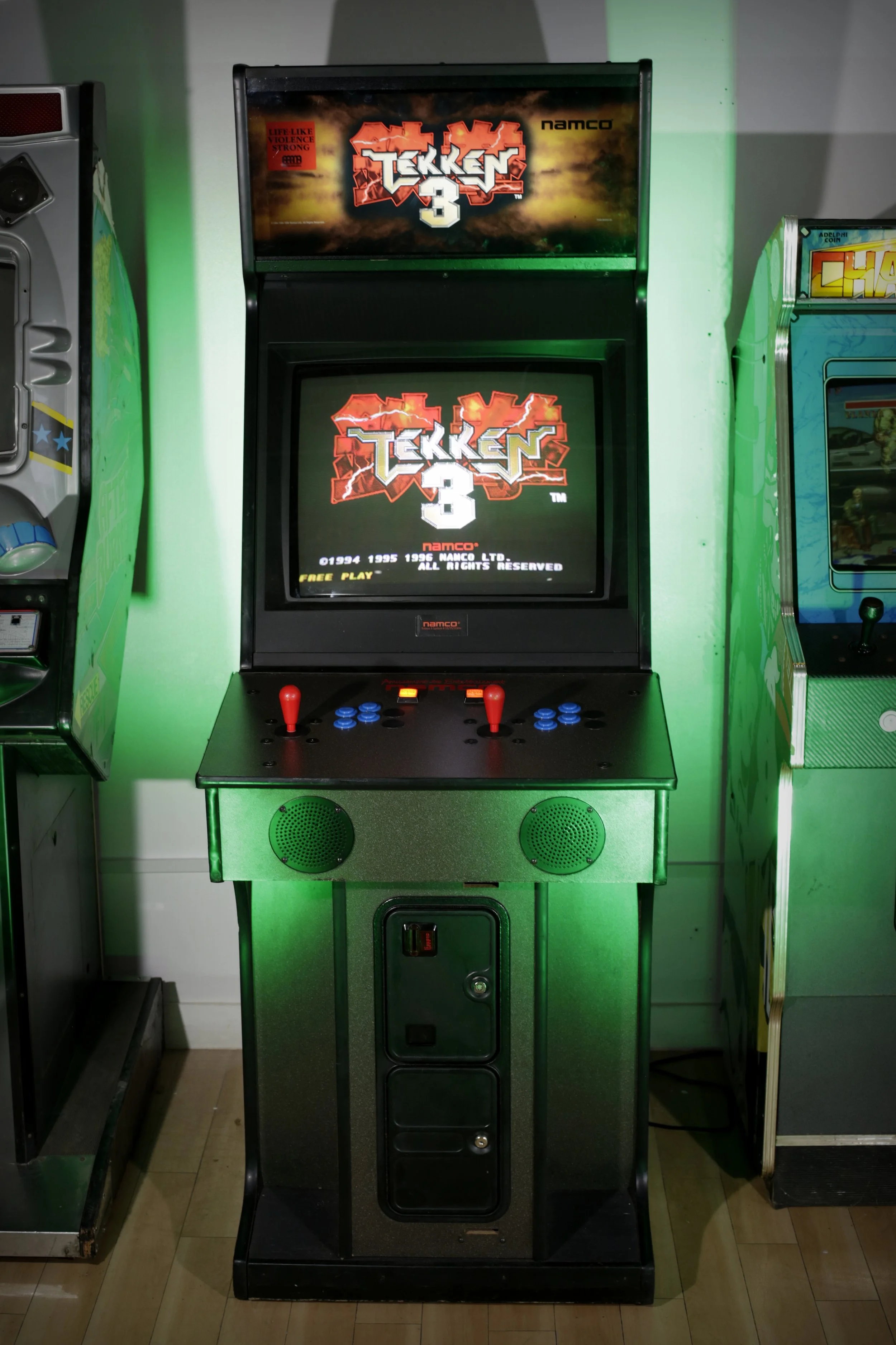Chase HQ
Chase H.Q. is a fast-paced racing game released in 1988. Players control a police officer in a black Porsche, teaming up with partner to catch escaping criminals.
In each level of the game, the player must relentlessly pursue the criminal to prevent their escape. Along the way, navigating split roads demands quick right turns for maximum speed. Strategic ramming of the criminal's car is key to bringing them to a halt and making the arrest. With a total of five adrenaline-pumping levels, each lasting between 60 to 70 seconds, players must stay sharp to succeed.
Chase HQ sets itself apart with its advanced technology when compared to Out Run, offering a thrilling gaming experience. The rogue's gallery of villains includes Ralph, Carlos, notorious Chicago pushers, a daring L.A. kidnapper, and an elusive Eastern Bloc Spy. The last villain's identity remains a mystery, adding an extra layer of intrigue. As players progress through the levels, bonus points are awarded based on their performance, with a grand prize of 5,000,000 points awaiting those skilled enough to beat the game. Get ready for high-speed pursuits and heart-pounding action at every turn!
Paperboy
Paperboy is an arcade game by Atari Games released in 1985. Play as a paperboy delivering The Daily Sun on a bicycle. The arcade version uses bike handlebars as a controller. Paperboy delivers a unique arcade experience and remains a fan favourite to this day.
The player controls a paperboy riding a bike delivering newspapers to a series of houses that are listed as customers. Timing is required to get the newspaper into or around the mailboxes of the customers houses. Houses that aren’t customers can be vandalised by throwing newspapers through windows etc.
Avoid obstacles like break-dancers, RC Cars and people fighting to get to the final BMX track area, complete that to finish the level.
The game ends when you either run out of lives or lose all of your customers.
Out Run
Released in 1986 and programmed by gaming legend Yu Suzuki, Out Run is widely Regarded as not only one of the greatest arcade racers of all time, but one of the vey best arcade machines ever made.
Controlling a Ferrari Testarossa with your girlfriend by your side, Out Run takes you through a branching set of tracks on a point to point race against the clock, avoiding traffic such as other cars and trucks.
Every time you pass a checkpoint the landscape shifts and changes. From fields of brightly coloured flowers to desert scenes, Out Run really does take you on a journey.
Fast paced and with an incredible iconic soundtrack, Out Run holds up surprisingly well for a game that is nearly 40 years old!
Pole Position
Pole Position is a groundbreaking racing arcade video game created by Namco in 1982 and licensed to Atari, Inc. for distribution in the United States, it quickly became a standout title of the golden age of arcade gaming.
Pole Position was the first racing video game to feature a track based on a real racing circuit. It was also the first game to feature a qualifying lap, requiring the player to complete a time trial before they can compete in Grand Prix races. Once the player has qualified, they must complete the race in the time allowed, avoiding collisions with CPU-controlled opponents and billboards along the sides of the track. The game's North American distributor, Atari, publicized the game for its "unbelievable driving realism" in providing a Formula 1 experience behind a racing wheel. The game's graphics featured full-colour landscapes with scaling sprites, including race cars and other signs, and a pseudo-3D, third-person, rear perspective view of the track, with its vanishing point swaying side to side as the player approaches corners, accurately simulating forward movement into the distance. While earlier three-dimensional arcade driving games emphasized staying on the road while avoiding crashes, Pole Position gives a higher reward for passing rival cars and finishing among the leaders.
Donkey Kong Jnr.
Donkey Kong Jr. is a classic arcade platform game developed by Nintendo in 1982. In this sequel to Donkey Kong, the roles are reversed - Mario is now the antagonist and Donkey Kong Jr. must rescue his captured father. Originally released in arcades, the game later became available on various home gaming systems. In the North American arcade version and other non-Nintendo conversions, the title is displayed as Donkey Kong Junior. The game was primarily created by Shigeru Miyamoto and Gunpei Yokoi, who was the company's chief engineer. Miyamoto also contributed to the graphics, while Yoshio Sakamoto assisted with the design. The music for the game was composed by Yukio Kaneoka, maintaining the same level of quality as its predecessor.
Donkey Kong Jr. is a platformer consisting of four distinct stages. DK Jr. has the ability to move left and right, jump, and use vines/chains/ropes to ascend higher on the screen. By holding onto a single vine, he can slide down faster, or by holding onto two, he can climb faster. The enemies in the game include "Snapjaws", which look like bear traps with eyes; bird-like creatures known as "Nitpickers", some of which attack by dropping eggs; and "Sparks" that move along the wiring in one of Mario's hideouts. DK Jr. can jump over these enemies while on platforms, switch between vines/chains/ropes to avoid them, or knock down pieces of fruit that will eliminate any enemy they come into contact with.
To progress through the first three stages, DK Jr. must reach the key next to his father's cage, causing Mario to flee while pushing the cage off the screen. In the fourth stage, DK Jr. must insert six keys into locks on the top platform to free Donkey Kong. Following a short cutscene, the player is returned to the first stage with increased difficulty. A bonus timer is active throughout each stage, and any remaining points on it are added to the player's score upon completion.
DK Jr. loses a life if he comes into contact with any enemy or projectile, falls from too great a height, touches the water and falls off the screen, or if the bonus timer reaches zero. The game concludes when the player exhausts all of their lives.
After Burner II
After Burner was created by Sega in 1987 as a rail shooter arcade video game. Players take control of an American F-14 Tomcat fighter jet and have to eliminate enemies in each of the eighteen stages. The jet comes with a machine gun and a set of heat-seeking missiles. The game features a third-person perspective, similar to Sega's Space Harrier (1985) and Out Run (1986). It operates on the Sega X Board arcade system, known for its surface and sprite rotation capabilities.
Like Out Run before it After Burner was developed by Yu Suzuki and the Sega AM2 division. Development began in December 1986, shortly after the completion of Out Run, under a cloud of secrecy. Suzuki drew inspiration from the 1986 films Top Gun and Laputa: Castle in the Sky; originally planning for a Laputa-inspired aesthetic, he ultimately opted for a Top Gun style to ensure the game's appeal to a global audience. The game was designed outside the company at "Studio 128," as Sega had adopted a flexible work schedule to allow for projects to be undertaken off-site. A revised version, After Burner II, featuring throttle controls, was released later the same year. This is the game you will find in most places.
After Burner was a massive success for Sega and was one of the worlds best selling arcade machines of 1987/88.
Take control of an F-14 Tomcat jet in the game as you launch from the SEGA Enterprise aircraft carrier and embark on a mission to eliminate enemy jets across 18 stages.
The jet is equipped with a machine gun and a set amount of heat-seeking missiles. Weapons can be restocked by a different aircraft once certain levels are completed. The game is controlled by a flight stick with force feedback.
Look out for the flashing red lights at the top of the cabinet, these indicate when an enemy has a lock on you. A quick left/right or right/left action will perform a roll and and evade the attack.
Gauntlet
Released in 1985 from Atari Games, Gauntlet is a fantasy-themed hack-and-slash arcade video game. It's recognised as one of the very first multiplayer dungeon crawl arcade games.
Instantly recognisable for its striking four-player cab, Gauntlet has gone on to be regarded as classic.
In this game, players navigate through a series of top-down, third-person, orthographic mazes. Their objective is to eliminate monsters, gather treasures, and find and reach the designated exit in each level. Throughout the game, players can discover special items that enhance their character's health, unlock doors, earn additional points, and receive magical potions to eliminate all enemies on the screen.
Players can choose to control one of four fantasy-based characters in the game: Thor, a warrior; Merlin, a wizard; Thyra, a valkyrie; or Questor, an Elf. While their names are displayed on the cabinet artwork, in-game they are only referred to by their class titles. Each character has unique strengths and weaknesses. For example, the warrior is strongest in hand-to-hand combat, the wizard has the most powerful magic, the valkyrie has the best armour, and the Elf moves fastest.
The game features a variety of fantasy monsters as enemies, such as ghosts, grunts, demons, lobbers, sorcerers, and thieves. They all spawn from specific generators, which can be taken out. Although there are no boss characters, the most formidable foe is Death, who can only be defeated with a magic potion. Otherwise, Death will disappear on its own after sapping a certain amount of the player's health.
As you advance through the levels, the difficulty ramps up, requiring players to cooperate by sharing items and strategically handling monsters. Health slowly depletes over time, adding a time pressure element. If a character's health hits zero, they can be revived by spending a game credit within a specific time window. This mechanic allows players to continue playing, but their final score will be impacted by the number of credits spent.
Besides being able to accommodate up to four players simultaneously, the game is also famous for the narrator's voice, which is generated by a Texas Instruments TMS5220C speech chip. The narrator, voiced by Ernie Fosselius, frequently reiterates the game's rules, such as: "Shots do not hurt other players, yet", "Remember, don't shoot food", "Elf shot the food", and "Warrior needs food, badly". Additionally, the narrator occasionally comments on the battle by saying, "I've not seen such bravery" or "Let's see you get out of here". When a player's life force points drop below 200, the narrator states, "Your life force is running out", "Elf needs food", or "Valkyrie is about to die".
Galaxian
Namco's Galaxian, which came out in 1979, is a popular fixed shooter arcade game. You take on the role of the Galaxip starfighter, fighting off waves of aliens to keep Earth safe. Your task is to destroy each alien formation as they descend towards you.
Created by Namco engineer Kazunori Sawano, Galaxian was developed as a response to Taito's Space Invaders, which had become a huge hit in Japan the year before. Sawano aimed to make the game simple and easy to grasp, drawing inspiration from Star Wars for the space combat theme. Originally, the enemies resembled TIE Fighters from the film. Galaxian was groundbreaking for its RGB colour graphics and tile-based hardware system, allowing for animated sprites and scrolling, although the scrolling was limited to the starfield background.
Galaxian was a groundbreaking arcade game by Namco, achieving great success in both Japan and the United States, where it sold over 50,000 units and cementing it as one of the best selling arcade games of all time. It was praised for its gameplay and colourful graphics, becoming one of the best-selling arcade games of its time. Its legacy lives on through sequels like Galaga.
In Galaxian, players control the Galaxip starship to eliminate aliens in each round. Enemies come in formation with escort ships, the Galaxian Flagship and Galboss. They will divebomb towards the player while shooting projectiles. The Galaxip can only shoot one shot at a time until the missile either hits an enemy or the top of the screen. This isn’t a design choice but more due to hardware limitations at the time.
Flagships will swoop down with two red escort ships - hitting all three will give the player bonus points, with even more points given for taking out the flagship. Enemy activity will intensify as the game goes on, along with the amount of shots fired by the enemies. Rounds are shown by small flags at the bottom of the screen. The game's attract mode displayed a brief message, saying "WE ARE THE GALAXIANS. MISSION: DESTROY ALIENS"
Asteroids
Released in November 1979 by Atari, Inc., Asteroids is a popular space-themed multidirectional shooter arcade video game developed by Lyle Rains and Ed Logg. Players pilot a spaceship through an asteroid field, aiming to eliminate asteroids and flying saucers without getting hit. The game gets progressively more difficult with each new wave of asteroids.
Asteroids was born from a meeting between Logg and Rains, who decided to utilise hardware from Howard Delman's Lunar Lander. The game was inspired by an unfinished project called Cosmos and drew elements from Spacewar!, Computer Space, and Space Invaders. The two-dimensional view of the game is rendered on a vector display that wraps around both screen axes.
Asteroids was a standout success during the golden age of arcade games, selling 47,840 upright cabinets and 8,725 cocktail cabinets. It was, and still is loved, by players and had a big impact on game developers.
In Asteroids, the goal is to eliminate asteroids and saucers. The player manoeuvres a triangular ship that has the ability to rotate, shoot, and thrust forward. Once the ship is set in motion, it will keep moving until the player changes its direction. By using hyperspace, the ship can vanish and reappear in a different spot on the screen, but there's a chance of self-destruction or collision with an asteroid.
Each level begins with a few large asteroids floating around in different directions on the screen. These objects will wrap around the edges of the screen, so if an asteroid goes off the top, it will reappear at the bottom and keep moving in the same direction. When you shoot an asteroid, it breaks into smaller, faster-moving pieces that are harder to hit but worth more points. Flying saucers will also show up from time to time - the big saucer shoots randomly and not very accurately, while the small saucer takes aim more frequently at your ship. Once you reach a score of 40,000, only the small saucer will appear. As your score goes up, the small saucer's shots become more precise until it's firing with extreme accuracy. After you clear the screen of all asteroids and saucers, a new set of large asteroids will appear, signaling the start of the next level. The game becomes more challenging as the number of asteroids increases, especially once your score hits between 40,000 and 60,000. You'll begin the game with 3-5 lives and earn an extra life for every 10,000 points you score. The game will continue until you lose your last ship, at which point it will end. If you manage to reach 99,990 points, the machine will "turn over," marking the highest possible score you can achieve.
Point Blank
Point Blank, also known as Gun Bullet (ガンバレット, Gan Baretto), or Gunvari (ガンバリ, Ganbari) in Japan, is a collection of light gun shooter games created by Namco. The series made its debut in arcades back in 1994.
Using Players can use two attached light guns (light blue or pink), to hit targets onscreen. The game features non-violent shooting contests with challenges like shooting player-coloured bulls-eyes, cardboard criminals, and protecting characters Dr. Don and Dr. Dan. Players can choose from different difficulty levels and must complete a certain number of stages to finish the game.
Each group of missions consists of four tasks that players can take on in any order. Generally, players are limited to three lives for the entire game, although this might change depending on the settings of the arcade cabinet. While most levels provide an endless amount of bullets, some have a finite supply of ammo. Players will lose lives if they fail to meet the stage quota or shoot at prohibited targets like Bombs, Civilians, or the opponent's colour targets.
In the game, there are six different types of stages to play. These include Accuracy, Intelligence, Memory, Simulation, Visual Acuity, and Speed. Each stage has its own unique challenge for players to overcome.
Once players finish all levels, their performance will be evaluated. The ranking in Point Blank depends on the total points earned, remaining lives, and continues used. Players will then receive suggestions to move up to a harder level, challenge a friend, go back to an easier level, or practice further.
Out Run 2 SP
Released in 2003 by Sega, OutRun 2 remains faithful to the racing style of the classic 1986 original. Again players take control of a Ferrari with a friend as the passenger, navigating through 5 out of 15 stages. Just like in the first, players have the freedom to select their route and the music playing in the background.
This time you have a choice from a selection of 7 Feraris’s including the Testarossa which featured in the original.
The games soundtrack was also rewritten with remixes of the 3 tracks from the original game and 4 entirely new tracks. The original games music is also unlockable.
The game had a massive graphical improvement from the original with smoother graphics and faster animations.
Another major improvement from the 1st game was the ability to link up to 4 machines together in networked play.
Gameplay improvements included, a drift and slipstream mechanic which, when performed correctly, gives the player a speed boost.
The single player game features 3 ways to play.
Outrun Mode – This follows the same game mode as the original game. The player drives through 5 of the 15 different stages, selecting the next course via forks on the road. There is a time limit which is extended when the player passes through checkpoints.
Heart Attack Mode – The driver navigates through an open-ended course within a time limit, while the passenger frequently asks for specific stunts and actions. These requests, carried out in marked sections of the course, can include passing traffic cars, drifting around bends, driving through marked lanes, knocking over cones, and simply avoiding crashes for as long as possible. If successful, the player will earn heart points and be graded at the end of the request section. At the end of the stage, the player will receive an average grade based on their performance during previous stunts. Crashing into the scenery or driving off-road at any time will result in the player losing hearts. Achieving a satisfying grade and reaching the goal within the time limit will lead to a more romantic ending.
Time Attack Mode – The player competes against a 'ghost' car on a chosen track, trying to beat the time limit. Time checks are given to the player at different points throughout the race.
In 2004, Sega released an upgrade to the OutRun 2 arcade game, titled OutRun 2 SP. The upgrade added 15 all-new courses which are predominantly based around a new World theme. This updated version is what you can play at Square Eye.
Sega Rally 2
Sega Rally 2 was created by Sega for the Model 3 arcade hardware as an arcade racing game. It serves as the follow-up to Sega Rally Championship from 1994. The game made its debut in arcades in February 1998.
Just like the first game, Sega Rally Championship, the aim of Sega Rally 2 is to drive through tracks, reach checkpoints, and earn more time to reach the finish line. This sequel introduced new cars, various environment settings like snowy tracks and island courses, and multiple circuits within each environment type. It even had an updated Desert track from the original game!
The game's development kicked off in March 1997, led by producer Tetsuya Mizuguchi. About half of the development team came from Sega AM Annex, while the rest were recruited from various internal studios within Sega. The team even designed their own development tools for the project.
Sega Rally 2 boasts an increased car roster from the original game.
Peugeot 306 Maxi
Toyota Corolla WRC
Ford Escort WRC
Subaru Impreza WRC
Mitsubishi Lancer Evolution V
Lancia Stratos HF
As well as two unlockable cars from the original:
Toyota Celica GT-Four ST205
Lancia Delta HF Integrale
Known for it’s incredibly striking cabinet, designed by Sega AM4, Sega Rally 2 remains a brilliant game and a machine we are delighted to have in Square Eye.
Rave Racer
Released by Namco in 1995, Rave Racer is an arcade racing game that runs on Namco System 22 hardware, and is the third entry in the Ridge Racer series, succeeding Ridge Racer and Ridge Racer 2. The Cabinet could be linked together for up to 8 players simultaneously.
Rave Racer introduces two additional tracks and the option to play the original two, along with several handling adjustments, force feedback steering, and enhanced car and racetrack visuals compared to Ridge Racer 2. The new tracks feature multiple side roads, with some taking longer to complete a full lap than others. It also has a new soundtrack.
Like its two predecessors the gameplay features driving a car around a looping track for 3 laps before the time expires. Checkpoints along the course add extra seconds to the time limit.
The cabinet features a button to change the view, either inside or outside the car.
Rave Racer was Japans highest grossing arcade machine of 1996 and remains one of our favourites to this day!
Track & Field
An all time classic, Track & Field, known as Hyper Olympic in Japan and Europe, is an Olympic-inspired sports video game created by Konami and launched as an arcade game in 1983. In Europe, the game was first released as Hyper Olympic in 1983, then rebranded as Track & Field in early 1984.
Gamers participate in a variety of sporting events, many of which require rapidly pressing two buttons to help the character move faster on the screen. The game is set up in a side-scrolling format, showing one or two tracks, a scoreboard with world records and current runs, and a lively crowd in the background.
The games simplistic controls yet steep difficulty curve made it an instant success, pushing it to becoming one of the most successful arcade games of 1984. Konami/Centuri even organised a Track & Field competition that attracted over 1 million players.
Using the two buttons to run, hit in an alternating pattern and a single action button, players compete in six events:
100m Dash
Long Jump
Javelin
110m Hurdles
Hammer Throw
High Jump
These consist of varying degrees of button bashing and timing and players must hit the qualifying criteria to progress.
Track & Field can be played by up to four players, although only two can play at any one time.
Track & Field and its sequel Hyper Sports spawned an entire genre of sports games that utilised similar mechanics.
Tekken 3
The third entry in the phenomenally successful Tekken series and regarded as one of the best, fighting game Tekken 3 was originally released in arcades in 1997.
Tekken 3 introduces many new cast of characters, including the debut of several now-staple characters like Jin Kazama, Ling Xiaoyu, Bryan Fury, Eddy Gordo, Hwoarang and Julia Chang, taking the total roster to twenty-three characters.
The arcade cabinet was a massive success selling 35,000 units.
Tekken 3 is the first game in the series to really take advantage of the 3D nature of its environments. Players can sidestep attacks into and out of the screen. Fighters now jump at more sensible heights so that jumping can no longer be used to avoid low attacks. This results in a more balanced gameplay experience that emphasises the strategic use of sidestep dodges. Reversals, which were initially limited to specific characters in Tekken 2, are now accessible to all fighters. Other enhancements include faster recoveries from knockdowns, increased opportunities to escape tackles and stuns, a wider selection of moves that facilitate juggling, and the addition of new combo throws.
With Tekken 3 being set 20 years after Tekken 2 only six of that games characters make a return, resulting in an impressive array of 15 entirely new characters.
Indiana Jones & The Temple of Doom!
Indiana Jones and the Temple of Doom is an arcade action game created and released by Atari Games in 1985. The game is inspired by the 1984 film of the same name. It’s the first Atari System 1 arcade game to feature digitised speech, including voice recordings of Harrison Ford as Indiana Jones and Amrish Puri as Mola Ram, as well as music from the film by John Williams.
The game takes place over three distinct levels as the player takes on the role of Indy. The first level has you running around a cave, climbing ladders in an attempt to free the slave children from their cages. You will need to avoid or beat Thugee guards as you go. To do this Indy is armed with his trusty whip which can be used to open the cages, whip the guards and traverse gaps.
The second level has Indy escaping in a mine cart whilst being chased by guards. Avoid dead ends, whip guards and oil drums to slow down the pursuit.
The final level takes place in the temple where Indy must grab the Sankara stone.
The game repeats this four times with the difficulty increasing each time. On the final run through the temple alter scene is replaced with the final showdown against Mola Ram on a rope bridge. Should the player prevail then the game enters a bonus level which remains until all lives are lost.
The game remains a firm favourite and is one we have been after for some time. One might say it was one of our Holy Grail cabs.
Berzerk
Released in 1980 by Stern Electronics of Chicago, Berzerk is a multidirectional shooter game designed by Alan McNeil. It is recognized as one of the earliest arcade video games to utilize speech synthesis, following Taito's Stratovox. In the game, players navigate through top-down, maze-like rooms filled with armed robots.
Berzerk can be played either 1 or 2 player, with players taking turns. Each controls a different coloured character green or purple.
To play the game, the player uses a joystick and a firing button to control a laser-style weapon while moving through a maze. The player must avoid getting shot by robots, running into them, or being electrocuted by the maze walls. And most importantly, steer clear of the games main baddie Evil Otto!
Evil Otto is represented as a bouncing ball with a smiley face. The character is unusual as a baddie for games of this period in that he is indestructible. Whilst there are robots on the screen he moves pretty slowly and is easily avoidable but as soon as the stage is cleared he matches the speed of the player, moving side to side and even faster when moving up and down. To escape the player needs to exit the maze through one of the openings and progressing to the next level.
Berzerk rightly sits near the very top of all time great arcade games. From the synthesised speech, to the brilliant gameplay, its legacy has been felt across all parts of gaming and movie history.
The gameplay is timeless and it is one well worth checking out on any visit to Square Eye.
Golden Tee Supreme Edition
Incredible Technologies' Golden Tee Golf series stands out for its innovative trackball control system, allowing players to adjust the power, direction, and spin of their shots. Offering different play modes such as 18-hole golf, closest to the pin, and online tournaments (Disabled on our cab), it has garnered a dedicated fan base over the years.
Originally designed as a large scale golfing simulator, creator Larry Hodgson switched tracks when the original game was cancelled. Many early Golden Tee games were sent out in kits so that places could convert cabs they already had. A network connection meant that players could compete virtually for actual cash prizes. This meant the game ended up more in bars and clubs than arcades. However, Golden Tee still plays great and even without the lure of £1000, it is still a popular cabinet at Square





